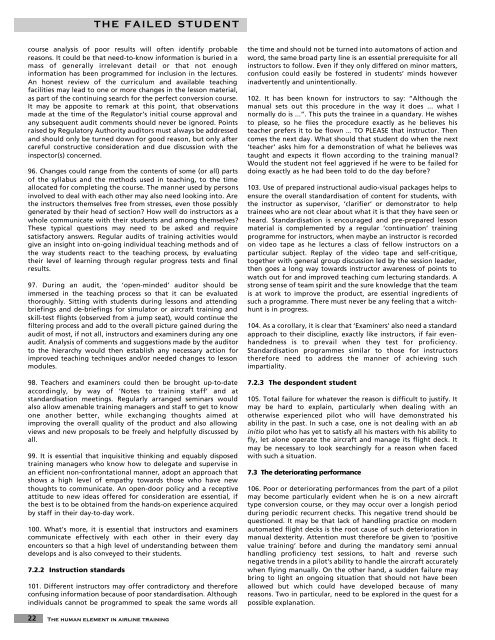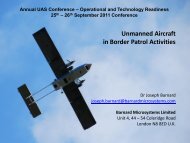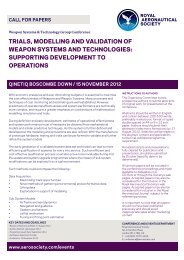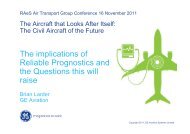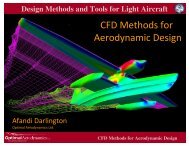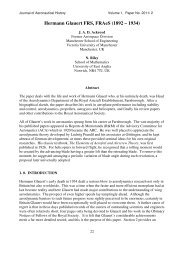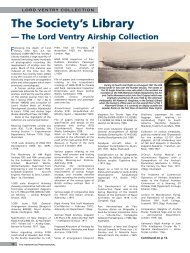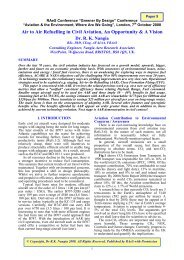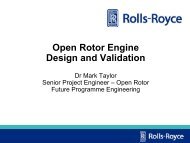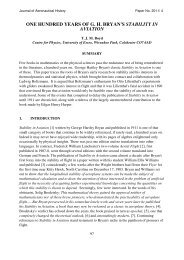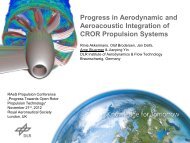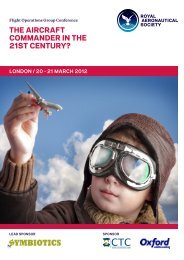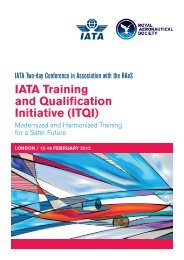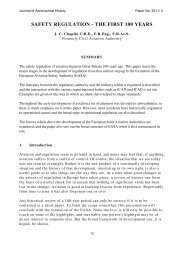The human element in airline training - Royal Aeronautical Society
The human element in airline training - Royal Aeronautical Society
The human element in airline training - Royal Aeronautical Society
You also want an ePaper? Increase the reach of your titles
YUMPU automatically turns print PDFs into web optimized ePapers that Google loves.
22<br />
THE FAILED STUDENT<br />
course analysis of poor results will often identify probable<br />
reasons. It could be that need-to-know <strong>in</strong>formation is buried <strong>in</strong> a<br />
mass of generally irrelevant detail or that not enough<br />
<strong>in</strong>formation has been programmed for <strong>in</strong>clusion <strong>in</strong> the lectures.<br />
An honest review of the curriculum and available teach<strong>in</strong>g<br />
facilities may lead to one or more changes <strong>in</strong> the lesson material,<br />
as part of the cont<strong>in</strong>u<strong>in</strong>g search for the perfect conversion course.<br />
It may be apposite to remark at this po<strong>in</strong>t, that observations<br />
made at the time of the Regulator’s <strong>in</strong>itial course approval and<br />
any subsequent audit comments should never be ignored. Po<strong>in</strong>ts<br />
raised by Regulatory Authority auditors must always be addressed<br />
and should only be turned down for good reason, but only after<br />
careful constructive consideration and due discussion with the<br />
<strong>in</strong>spector(s) concerned.<br />
96. Changes could range from the contents of some (or all) parts<br />
of the syllabus and the methods used <strong>in</strong> teach<strong>in</strong>g, to the time<br />
allocated for complet<strong>in</strong>g the course. <strong>The</strong> manner used by persons<br />
<strong>in</strong>volved to deal with each other may also need look<strong>in</strong>g <strong>in</strong>to. Are<br />
the <strong>in</strong>structors themselves free from stresses, even those possibly<br />
generated by their head of section? How well do <strong>in</strong>structors as a<br />
whole communicate with their students and among themselves?<br />
<strong>The</strong>se typical questions may need to be asked and require<br />
satisfactory answers. Regular audits of tra<strong>in</strong><strong>in</strong>g activities would<br />
give an <strong>in</strong>sight <strong>in</strong>to on-go<strong>in</strong>g <strong>in</strong>dividual teach<strong>in</strong>g methods and of<br />
the way students react to the teach<strong>in</strong>g process, by evaluat<strong>in</strong>g<br />
their level of learn<strong>in</strong>g through regular progress tests and f<strong>in</strong>al<br />
results.<br />
97. Dur<strong>in</strong>g an audit, the ‘open-m<strong>in</strong>ded’ auditor should be<br />
immersed <strong>in</strong> the teach<strong>in</strong>g process so that it can be evaluated<br />
thoroughly. Sitt<strong>in</strong>g with students dur<strong>in</strong>g lessons and attend<strong>in</strong>g<br />
brief<strong>in</strong>gs and de-brief<strong>in</strong>gs for simulator or aircraft tra<strong>in</strong><strong>in</strong>g and<br />
skill-test flights (observed from a jump seat), would cont<strong>in</strong>ue the<br />
filter<strong>in</strong>g process and add to the overall picture ga<strong>in</strong>ed dur<strong>in</strong>g the<br />
audit of most, if not all, <strong>in</strong>structors and exam<strong>in</strong>ers dur<strong>in</strong>g any one<br />
audit. Analysis of comments and suggestions made by the auditor<br />
to the hierarchy would then establish any necessary action for<br />
improved teach<strong>in</strong>g techniques and/or needed changes to lesson<br />
modules.<br />
98. Teachers and exam<strong>in</strong>ers could then be brought up-to-date<br />
accord<strong>in</strong>gly, by way of ‘Notes to tra<strong>in</strong><strong>in</strong>g staff’ and at<br />
standardisation meet<strong>in</strong>gs. Regularly arranged sem<strong>in</strong>ars would<br />
also allow amenable tra<strong>in</strong><strong>in</strong>g managers and staff to get to know<br />
one another better, while exchang<strong>in</strong>g thoughts aimed at<br />
improv<strong>in</strong>g the overall quality of the product and also allow<strong>in</strong>g<br />
views and new proposals to be freely and helpfully discussed by<br />
all.<br />
99. It is essential that <strong>in</strong>quisitive th<strong>in</strong>k<strong>in</strong>g and equably disposed<br />
tra<strong>in</strong><strong>in</strong>g managers who know how to delegate and supervise <strong>in</strong><br />
an efficient non-confrontational manner, adopt an approach that<br />
shows a high level of empathy towards those who have new<br />
thoughts to communicate. An open-door policy and a receptive<br />
attitude to new ideas offered for consideration are essential, if<br />
the best is to be obta<strong>in</strong>ed from the hands-on experience acquired<br />
by staff <strong>in</strong> their day-to-day work.<br />
100. What’s more, it is essential that <strong>in</strong>structors and exam<strong>in</strong>ers<br />
communicate effectively with each other <strong>in</strong> their every day<br />
encounters so that a high level of understand<strong>in</strong>g between them<br />
develops and is also conveyed to their students.<br />
7.2.2 Instruction standards<br />
101. Different <strong>in</strong>structors may offer contradictory and therefore<br />
confus<strong>in</strong>g <strong>in</strong>formation because of poor standardisation. Although<br />
<strong>in</strong>dividuals cannot be programmed to speak the same words all<br />
<strong>The</strong> <strong>human</strong> <strong>element</strong> <strong>in</strong> airl<strong>in</strong>e tra<strong>in</strong><strong>in</strong>g<br />
the time and should not be turned <strong>in</strong>to automatons of action and<br />
word, the same broad party l<strong>in</strong>e is an essential prerequisite for all<br />
<strong>in</strong>structors to follow. Even if they only differed on m<strong>in</strong>or matters,<br />
confusion could easily be fostered <strong>in</strong> students’ m<strong>in</strong>ds however<br />
<strong>in</strong>advertently and un<strong>in</strong>tentionally.<br />
102. It has been known for <strong>in</strong>structors to say: “Although the<br />
manual sets out this procedure <strong>in</strong> the way it does ... what I<br />
normally do is ...”. This puts the tra<strong>in</strong>ee <strong>in</strong> a quandary. He wishes<br />
to please, so he flies the procedure exactly as he believes his<br />
teacher prefers it to be flown ... TO PLEASE that <strong>in</strong>structor. <strong>The</strong>n<br />
comes the next day. What should that student do when the next<br />
‘teacher’ asks him for a demonstration of what he believes was<br />
taught and expects it flown accord<strong>in</strong>g to the tra<strong>in</strong><strong>in</strong>g manual?<br />
Would the student not feel aggrieved if he were to be failed for<br />
do<strong>in</strong>g exactly as he had been told to do the day before?<br />
103. Use of prepared <strong>in</strong>structional audio-visual packages helps to<br />
ensure the overall standardisation of content for students, with<br />
the <strong>in</strong>structor as supervisor, ‘clarifier’ or demonstrator to help<br />
tra<strong>in</strong>ees who are not clear about what it is that they have seen or<br />
heard. Standardisation is encouraged and pre-prepared lesson<br />
material is complemented by a regular ‘cont<strong>in</strong>uation’ tra<strong>in</strong><strong>in</strong>g<br />
programme for <strong>in</strong>structors, when maybe an <strong>in</strong>structor is recorded<br />
on video tape as he lectures a class of fellow <strong>in</strong>structors on a<br />
particular subject. Replay of the video tape and self-critique,<br />
together with general group discussion led by the session leader,<br />
then goes a long way towards <strong>in</strong>structor awareness of po<strong>in</strong>ts to<br />
watch out for and improved teach<strong>in</strong>g cum lectur<strong>in</strong>g standards. A<br />
strong sense of team spirit and the sure knowledge that the team<br />
is at work to improve the product, are essential <strong>in</strong>gredients of<br />
such a programme. <strong>The</strong>re must never be any feel<strong>in</strong>g that a witchhunt<br />
is <strong>in</strong> progress.<br />
104. As a corollary, it is clear that ‘Exam<strong>in</strong>ers’ also need a standard<br />
approach to their discipl<strong>in</strong>e, exactly like <strong>in</strong>structors, if fair evenhandedness<br />
is to prevail when they test for proficiency.<br />
Standardisation programmes similar to those for <strong>in</strong>structors<br />
therefore need to address the manner of achiev<strong>in</strong>g such<br />
impartiality.<br />
7.2.3 <strong>The</strong> despondent student<br />
105. Total failure for whatever the reason is difficult to justify. It<br />
may be hard to expla<strong>in</strong>, particularly when deal<strong>in</strong>g with an<br />
otherwise experienced pilot who will have demonstrated his<br />
ability <strong>in</strong> the past. In such a case, one is not deal<strong>in</strong>g with an ab<br />
<strong>in</strong>itio pilot who has yet to satisfy all his masters with his ability to<br />
fly, let alone operate the aircraft and manage its flight deck. It<br />
may be necessary to look search<strong>in</strong>gly for a reason when faced<br />
with such a situation.<br />
7.3 <strong>The</strong> deteriorat<strong>in</strong>g performance<br />
106. Poor or deteriorat<strong>in</strong>g performances from the part of a pilot<br />
may become particularly evident when he is on a new aircraft<br />
type conversion course, or they may occur over a longish period<br />
dur<strong>in</strong>g periodic recurrent checks. This negative trend should be<br />
questioned. It may be that lack of handl<strong>in</strong>g practice on modern<br />
automated flight decks is the root cause of such deterioration <strong>in</strong><br />
manual dexterity. Attention must therefore be given to ‘positive<br />
value tra<strong>in</strong><strong>in</strong>g’ before and dur<strong>in</strong>g the mandatory semi annual<br />
handl<strong>in</strong>g proficiency test sessions, to halt and reverse such<br />
negative trends <strong>in</strong> a pilot's ability to handle the aircraft accurately<br />
when fly<strong>in</strong>g manually. On the other hand, a sudden failure may<br />
br<strong>in</strong>g to light an ongo<strong>in</strong>g situation that should not have been<br />
allowed but which could have developed because of many<br />
reasons. Two <strong>in</strong> particular, need to be explored <strong>in</strong> the quest for a<br />
possible explanation.


